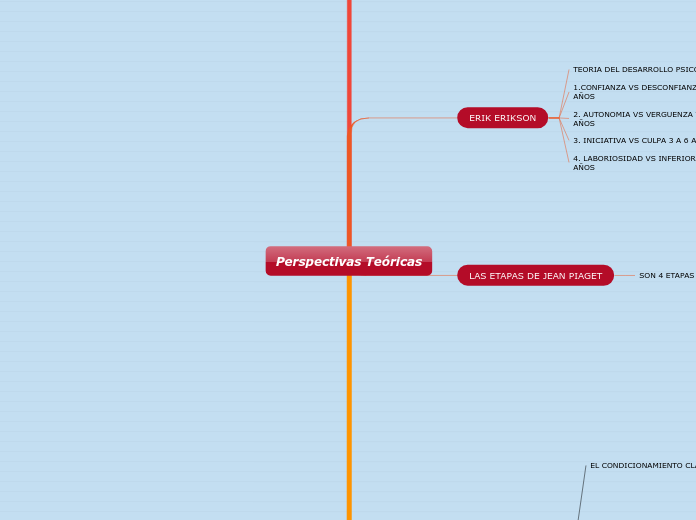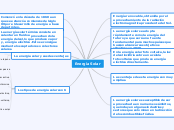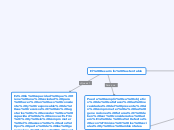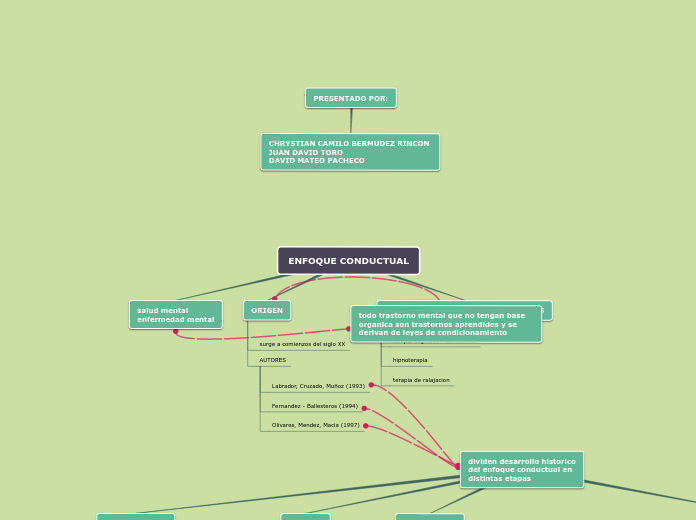Perspectivas Teóricas
To name your story, you have to think about the overall message and what you want your audience to understand from the story. Also, make it relevant and easy to remember.
ALBERT BANDURA
TEORIA DEL APRENDIZAJE SOCIAL
La teoría del aprendizaje social propone que el aprendizaje es un proceso cognitivo que tiene lugar en un contexto social y ocurre principalmente a través del reforzamiento, la observación o la instrucción directa, incluso en ausencia de reproducción motora o refuerzo directo.
EL CONDUCTISMO
EL CONDICIONAMIENTO OPERANTE
B.F SKINNER
Skinner enseñó a las palomas
a responder a barras de diferentes colores al recompensarías con alimento cuando por casualidad presionaban la barra correcta; entonces, demostró cómo el principio que subyace las respuestas de los animales podría usarse también para controlar la conducta humana. El principio
es que un organismo tenderá a repetir la conducta si a ésta le sigue una experiencia satisfactoria y a no repetirla si la experiencia posterior no es satisfactoria –para buscar recompensa y evitar
el castigo.
EL CONDICIONAMIENTO CLASICO
IVAN PAVLOV
Enseñó a los perros a
salivar al oír una campana y ofrecerles alimento en forma repetida inmediatamente después de sonar la campana. Debido a que los perros
habían aprendido a asociar el sonido de la campana con alimento –la campana eventualmente inducía la salivación aun cuando no apareciese ningún alimento. El famoso experimento de Pavlov demostró, el condicionamiento clásico
–un tipo de aprendizaje en el cual una persona o animal aprende a responder a un estímulo que originalmente no solicitaba tal respuesta, después de que el estímulo se asocia repetidamente
con otro estímulo que de ordinario sí la solicita.
LAS ETAPAS DE JEAN PIAGET
The ending of a story is essential. We all know that if the ending is weak, what happened before loses its importance. So make it unpredictable, but fair. A resolved ending answers all the questions and ties up any loose threads from the plot.
SON 4 ETAPAS COGNOSITIVAS
This is the closure section of the story.
See examples of possible outcomes below:
- all problems have been solved
- it's clear how each one of your characters ends up
- your main character is transformed by the challenge
4. ETAPA DE OPERACIONES FORMALES DESDE LOS 12 HASTA LA VIDA ADULTA
En este período los niños ganan la capacidad para utilizar una lógica que les permite llegar a conclusiones abstractas que no están ligadas a casos concretos.
3. ETAPA DE OPERACIONES CONCRETAS 7 A 12 AÑOS
Try answering these questions in order for you to come up with a closure:
- Have all problems been solved?
- Is it clear what happens with all your characters in the story?
- Has the challenged transformed your main character?
- How do the characters feel in the end?
En esta etapa, los niños empiezan a usar la lógica para llegar a conclusiones válidas, pero para lograrlo necesitan situaciones concretas y no abstractas.
2. ETAPA PREOPERACIONAL 2 A 7 AÑOS
En esta etapa, los niños empiezan a ganar la capacidad de ponerse en el lugar de los demás y por esta razón, son capaces de actuar y hacer juegos de rol
1. ETAPA SENSIOMOTRIZ 0 A 2 AÑOS
Try answering these questions to come up with a closure:
- Have all the problems been solved?
- Is there a clear picture of what happens with each character in the story?
- Has the challenge transformed your main character?
- How do the characters feel in the end?
Esta es la primera en el desarrollo cognitivo , ocurre entre el momento del nacimiento y la aparición de un lenguaje que se articula en frases simples
ERIK ERIKSON
The middle of the story is where you add layers of complications that will lead to the end. Reveal more about the character's journey. Did their personality go through changes? How did they overcome the challenges? And as you build up the story’s central conflict, make it more personal to that character. Also, from the middle act, you have to lead into the final act.
4. LABORIOSIDAD VS INFERIORIDAD 6 A 12 AÑOS
8. INTEGRIDAD VS DESESPERACION 60 AÑOS HASTA LA MUERTE
3. INICIATIVA VS CULPA 3 A 6 AÑOS
There wouldn't be any tension and excitement in your story if there weren't any obstacles in your character's way.
7. GENERATIVIDAD VS ESTANCAMIENTO 40 A 60 AÑOS
A story is nothing more than a character overcoming a series of difficulties to reach the desired goal. Obstacles usually create suspense and conflict. In overcoming obstacles, there is growth: weak becomes strong; hatred turns into love; sadness into happiness; wrong into right; lies into truth; or evil becomes good.
See a few examples below:
- stopping a meteor
- finding a killer
- finding love
2. AUTONOMIA VS VERGUENZA Y DUDA 2 A 3 AÑOS
Your character(s) need(s) motivation in order to solve the challenge(s).
6. INTIMIDAD VS AISLAMIENTO 20 A 40 AÑOS
Why does your character need to confront this challenge? What does he/she expect to accomplish by solving it?
See a few examples:
- will marry in 3 days
- can fix the mistakes of the past
1.CONFIANZA VS DESCONFIANZA 0 A 2 AÑOS
Each story has a main character and that character usually needs to solve a problem or challenge. The character's challenge is the one that creates tension throughout the story.
5. BUSQUEDA DE IDENTIDAD VS DIFUSION DE IDENTIDAD 12 A 20 AÑOS
In most stories, there are 3 challenges. The number 3 is a mystical number symbolizing completeness. Try to come up with interesting challenges with which your character needs to struggle.
See a few examples below:
- turns into a werewolf at night
- is sent back in time
TEORIA DEL DESARROLLO PSICOSOCIAL
SIGMUND FREUD
In the beginning of the story (or the exposition), you will need to introduce the setting and characters. You might also want to introduce the main conflict. This part of the story is important because it gives the reader necessary background information and maybe even a first insight into a character’s personality.
SUBCONSIENTE, EL YO, Y SUPER YO
The setting (time & place) of a story can change throughout the plot.
SUPER YO
Sensory details include sight, sound, touch, smell, and taste. These details are important because they create depth in your setting.
See a few examples below:
- the smell of fresh bread
- the scent of freshly cut grass
- rain falling onto the windshield etc.
El superyó representa los valores que los
padres y los
profesores) le comunican al niño, más que todo
a través de la identificación del niño con los padres del mismo sexo; el superyó incorpora los
“debes” y “no debes”
YO
The weather is an important element in your story because it can highly influence the ambiance and the mood of the characters.
El yo representa la razón o el sentido común; se desarrolla en algún momento durante el
primer año de edad y opera sobre el “principio
de realidad”
The most affected character is the main character. Write down here if he/she is affected by these weather conditions in any way. For example, if they lost a family member or their home during a hurricane, etc.
SUBCONSIENTE
The time of the story can also change. It can describe the event of a single day or can include an entire year's plot. Anyway, don't forget to mention it.
El subconsciente que está presente en el
momento del nacimiento, es la fuente de motivaciones y deseos; opera sobre el “principio del
placer”
TEORIA PSICOSOCIAL
Characters are essential to a good story. Usually, the protagonist(s) is/are the most affected by the plot. Introduce a character by focusing on their actions, interests, and occupation, as the physical appearance doesn't make a difference in most cases.
SON 5 ETAPAS
Type in the name of your character.
LA ETAPA GENITAL EMPIEZA EN LA PUBERTAD
Add other properties of the character.
SIENTE PLACER EN LOS GENITALES
LA ETAPA DE LATENCIA VA DESDE LOS 7 AÑOS HASTA LA PUBERTAD
Add other qualities/attributes of the character.
NO POSEE UNA ZONA ERÓGENA
LA ETAPA FALICA VA DESDE LOS 3 A 6 AÑOS
What is your character's main goal?
fight Evilfind lovedefeat his/her enemyrule the worldmake friendstime travelmake an awesome discoveryOther
SIENTE PLACER AL ORINAR
LA ETAPA ANAL VA DESDE LOS 18 MESES A 3 AÑOS
Which traits best describe the character's personality? Choose more if necessary:
introvertedloyalkindindependentquick-thinkingadventuresomeidealisticsweet-naturedcalmrisk-takercreativewittystrictfussyweirdclumsyharshaggressivecarelessclingingcowardlycrueldeceitfulimpulsiveOther
SIENTE PLACER RETIENIENDO EL ESFINTER
LA ETAPA ORAL OCUPA LOS PRIMEROS 18 MESES
Choose the type of your chacter:
Protagonist (main character)Antagonist (main character's opponent)Flat (stereotypical character)Round (his/ her personality develops throughout the story)Static (doesn't evolve as a person throughout the story)Dynamic (dramatical change in personality)Confidant (the main character trusts him/ her)Foil (contrasting character who enhances the personality of another character)Other
LA BOCA ES LA ZONA DEL PLACER










